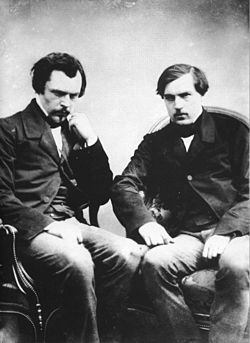Anh em nhà Goncourt

Anh em nhà Goncourt (tiếng Pháp: [ɡɔ̃kuːʁ]) bao gồm Edmond de Goncourt ([ɛdmɔ̃], 1822–96) và Jules de Goncourt ([ʒyl], 1830–70), là hai nhà văn Pháp thế kỷ XIX theo trường phái Tự nhiên.
Tiểu sử
[sửa | sửa mã nguồn]Họ bắt đầu sự nghiệp văn chương bằng việc ghi chép về kỳ nghỉ chung với nhau. Sau đó họ đã cho xuất bản sách về xã hội và nghệ thuật của Pháp và Nhật Bản ở Thế kỷ 18. Các tác phẩm của họ (Portraits intimes du XVIIIe siècle (1857), La Femme au XVIIIe siècle (1862), La du Barry (1878), and others) are made entirely out of documents, autograph letters, scraps of costume, engravings, songs, the unconscious self-revelations of the time.[1] In their volumes (e.g., Portraits intimes du XVIII siecle), they dismissed the vulgarity of the Second Empire in favour of a more refined age. They wrote the long Journal des Goncourt from 1851, which gives a view of the literary and social life of their time.
When they came to write novels, it was with a similar attempt to give the inner, undiscovered, minute truths of contemporary existence.[1] They published six novels, of which Germinie Lacerteux, 1865, was the fourth. It is based on the true case of their own maidservant, Rose Malingre, whose double life they had never suspected. After the death of Jules, Edmond continued to write novels in the same style.
According to the Encyclopædia Britannica Eleventh Edition:
[T]hey invented a new kind of novel, and their novels are the result of a new vision of the world, in which the very element of sight is decomposed, as in a picture of Monet. Seen through the nerves, in this conscious abandonment to the tricks of the eyesight, the world becomes a thing of broken patterns and conflicting colours, and uneasy movement. A novel of the Goncourts is made up of an infinite number of details, set side by side, every detail equally prominent. While a novel of Flaubert, for all its detail, gives above all things an impression of unity, a novel of the Goncourts deliberately dispenses with unity in order to give the sense of the passing of life, the heat and form of its moments as they pass. It is written in little chapters, sometimes no longer than a page, and each chapter is a separate notation of some significant event, some emotion or sensation which seems to throw sudden light on the picture of a soul. To the Goncourts humanity is as pictorial a thing as the world it moves in; they do not search further than "the physical basis of life," and they find everything that can be known of that unknown force written visibly upon the sudden faces of little incidents, little expressive moments. The soul, to them, is a series of moods, which succeed one another, certainly without any of the too arbitrary logic of the novelist who has conceived of character as a solid or consistent thing. Their novels are hardly stories at all, but picture-galleries, hung with pictures of the momentary aspects of the world.
They are buried together (in the same grave) in Montmartre Cemetery.
Legacy
[sửa | sửa mã nguồn]Edmond de Goncourt bequeathed his entire estate for the foundation and maintenance of the Académie Goncourt. Since 1903, the académie has awarded the Prix Goncourt, probably the most important literary prize in French literature.
The first English translation of Manette Salomon, translated by Tina Kover, was published in November 2017 by Snuggly Books.
Works
[sửa | sửa mã nguồn]Novels
- Sœur Philomène (1861)
- Renée Mauperin (1864)
- Germinie Lacerteux (1865)
- Manette Salomon (1867)
- Madame Gervaisais (1869)
and, by Edmond alone:
- La Fille Elisa (1878)
- Les Frères Zemganno (1879)
- La Faustin (1882)
- Chérie (1884)
Other
[sửa | sửa mã nguồn]- Journal des Goncourt, 1851-1896
- Portraits intimes du XVIIIe siècle (1857)
- La Femme au XVIIIe siècle (1862)
- La du Barry (1878)
- L’Art du XVIIIe siècle (French Eighteenth Century Painters) (1859–1875)
Ghi chú
[sửa | sửa mã nguồn]- ^ a b
 Một hoặc nhiều câu trước bao gồm văn bản từ một ấn phẩm hiện thời trong phạm vi công cộng: Chisholm, Hugh biên tập (1911). “Goncourt, De”. Encyclopædia Britannica. 7 (ấn bản thứ 11). Cambridge University Press. tr. 231.
Một hoặc nhiều câu trước bao gồm văn bản từ một ấn phẩm hiện thời trong phạm vi công cộng: Chisholm, Hugh biên tập (1911). “Goncourt, De”. Encyclopædia Britannica. 7 (ấn bản thứ 11). Cambridge University Press. tr. 231.
Tham khảo
[sửa | sửa mã nguồn]Liên kết ngoài
[sửa | sửa mã nguồn] GIẢM
27%
GIẢM
27%
 GIẢM
40%
GIẢM
40%
 GIẢM
17%
GIẢM
17%
![[Review sách] Xá lợi toàn thân - Bài Pháp Vô Ngôn](https://down-bs-vn.img.susercontent.com/sg-11134201-7rble-lluxxe4d8mzd69.webp) GIẢM
20%
GIẢM
20%
![[Tóm tắt và đánh giá] Bạn không thông minh lắm đâu | Cuốn sách tâm lý học thú vị bạn nên đọc vào năm 2024](https://down-bs-vn.img.susercontent.com/vn-11134201-23030-c1d4ivny4kov19.webp)




